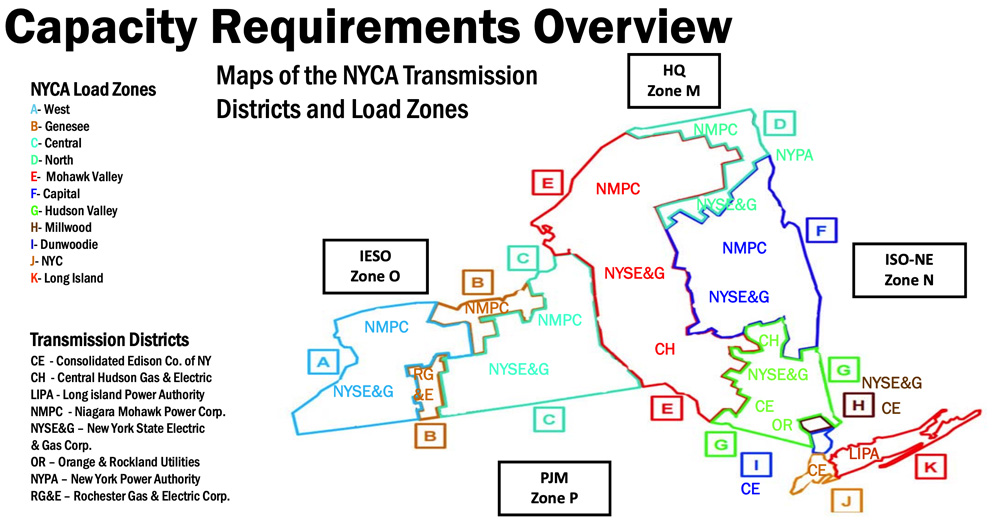
FERC on Thursday voted 4-1 to accept revisions to NYISO’s buyer-side market power mitigation (BSM) measures designed to prioritize evaluating New York state-subsidized resources, reversing its decision in September 2020 to reject the ISO’s proposal (ER20-1718-002).
The BSM measures are designed to prevent uneconomic resources from entering NYISO’s capacity market. Under Part A of the mitigation exemption test, the ISO exempts a new entrant from the offer floor if the forecast of capacity prices in the first year of a new entrant’s operation is higher than the default offer floor. Its proposed revisions, submitted to FERC in April 2020, would to place “public policy” resources (i.e., renewable resources, battery storage and other zero-emission resources) ahead of nonpublic policy resources in its evaluations.
NYISO argued that in light of New York state legislation, including enactment of the Climate Leadership and Community Protection Act (CLCPA), subsidized resources were more likely to be completed. Unlike in 2020, under a Republican majority, the commission this time agreed.
 NYISO
NYISO
“We are persuaded by evidence in the record indicating that NYISO’s proposed resequencing of resources is just and reasonable because it will minimize artificial capacity surpluses, which, as NYISO’s Market Monitoring Unit [Potomac Economics] explains, would otherwise occur ‘because the current Part A test can provide inefficient incentives for investment in new resources that are not needed,’” the commission said.
In addition to the CLCPA’s binding targets, the commission said that the Accelerated Renewable Energy Growth and Community Benefit Act provides for fast-track environmental review and permitting for major renewable energy facilities, and a number of nonpublic policy resources are expected to exit the market as a result of the state’s new “peaker rule” limiting NOx emissions.
FERC directed the ISO to submit a compliance filing within 30 days proposing a new effective date for the revisions no later than Aug. 1, the start of the next class year.
Reversal
FERC had approved several other of NYISO’s proposed revisions to the BSM measures in September 2020, including a formula that limited the amount of renewables that could be exempted. But its rejection of the Part A changes prompted a dissent from then-Commissioner Richard Glick and rehearing requests by the ISO, Equinor, New York Transmission Owners, the New York State Energy Research and Development Authority and the New York Public Service Commission. (See FERC Rejects NYISO Bid to Aid Public Policy Resources.)
The Republican majority at the time said NYISO’s plan was “unduly discriminatory because it does not provide sufficient justification for prioritizing the evaluation of public policy resources before nonpublic policy resources, independent of cost.”
Commissioner James Danly, now in the minority, said in a dissent that “the justifications offered in this order are simply unconvincing.”
“Our duty is to ensure just and reasonable rates pursuant to the [Federal Power Act], and not to determine whether NYISO’s proposal is consistent with federal, state, or municipal renewable energy policies,” Danly said.
Fellow Republican Commissioner Mark Christie concurred in a separate statement, taking exception to the majority’s reasoning.
“New York’s state law is discriminatory in its expressed preference for certain types of resources,” Christie said, while noting that the FPA does not pre-empt the state from doing so. “Does this make the NYISO’s tariff revisions — through which NYISO is acting necessarily to accommodate the reality of New York’s laws — produce rates that are ‘unjust, unreasonable and/or unduly discriminatory’ under the FPA? Under an ‘as-applied’ analysis of this specific, single-state ISO filing by NYISO — and under a practical approach — I do not find it so.”
Christie also said that there is no evidence that NYISO’s proposal would harm consumers in other states, and “if the people and businesses of New York do not like the impacts of their new state laws, their recourse is to the ballot box,” Christie said.


